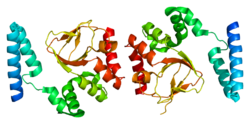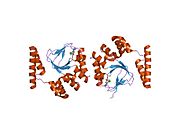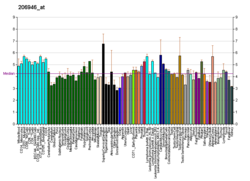HCN4
| HCN4 | |||||||||||||||||||||||||||||||||||||||||||||||||||
|---|---|---|---|---|---|---|---|---|---|---|---|---|---|---|---|---|---|---|---|---|---|---|---|---|---|---|---|---|---|---|---|---|---|---|---|---|---|---|---|---|---|---|---|---|---|---|---|---|---|---|---|
 | |||||||||||||||||||||||||||||||||||||||||||||||||||
| |||||||||||||||||||||||||||||||||||||||||||||||||||
| Identifiers | |||||||||||||||||||||||||||||||||||||||||||||||||||
| Aliases | HCN4, SSS2, hyperpolarization activated cyclic nucleotide gated potassium channel 4, BRGDA8, EIG18 | ||||||||||||||||||||||||||||||||||||||||||||||||||
| External IDs | OMIM: 605206; MGI: 1298209; HomoloGene: 3997; GeneCards: HCN4; OMA:HCN4 - orthologs | ||||||||||||||||||||||||||||||||||||||||||||||||||
| |||||||||||||||||||||||||||||||||||||||||||||||||||
| |||||||||||||||||||||||||||||||||||||||||||||||||||
| |||||||||||||||||||||||||||||||||||||||||||||||||||
| |||||||||||||||||||||||||||||||||||||||||||||||||||
| |||||||||||||||||||||||||||||||||||||||||||||||||||
| Wikidata | |||||||||||||||||||||||||||||||||||||||||||||||||||
| |||||||||||||||||||||||||||||||||||||||||||||||||||
Potassium/sodium hyperpolarization-activated cyclic nucleotide-gated channel 4 is a protein that in humans is encoded by the HCN4 gene.[5][6][7][8]
There are four HCN channels. HCN4 is prominently expressed in the pace maker region of the mammalian heart.[9] Some humans with bradycardia and Sick sinus syndrome have been shown to have mutations in their HCN4 gene.[10][11][12] The role of HCN channels in autonomic control of heart rate is currently a matter of ongoing investigation.[13][14][15][16]
Interactions
HCN4 has been shown to interact with HCN2.[17]
See also
References
- ^ a b c GRCh38: Ensembl release 89: ENSG00000138622 – Ensembl, May 2017
- ^ a b c GRCm38: Ensembl release 89: ENSMUSG00000032338 – Ensembl, May 2017
- ^ "Human PubMed Reference:". National Center for Biotechnology Information, U.S. National Library of Medicine.
- ^ "Mouse PubMed Reference:". National Center for Biotechnology Information, U.S. National Library of Medicine.
- ^ Ludwig A, Zong X, Stieber J, Hullin R, Hofmann F, Biel M (May 1999). "Two pacemaker channels from human heart with profoundly different activation kinetics". The EMBO Journal. 18 (9): 2323–9. doi:10.1093/emboj/18.9.2323. PMC 1171315. PMID 10228147.
- ^ Seifert R, Scholten A, Gauss R, Mincheva A, Lichter P, Kaupp UB (Aug 1999). "Molecular characterization of a slowly gating human hyperpolarization-activated channel predominantly expressed in thalamus, heart, and testis". Proceedings of the National Academy of Sciences of the United States of America. 96 (16): 9391–6. Bibcode:1999PNAS...96.9391S. doi:10.1073/pnas.96.16.9391. PMC 17793. PMID 10430953.
- ^ Hofmann F, Biel M, Kaupp UB (Dec 2005). "International Union of Pharmacology. LI. Nomenclature and structure-function relationships of cyclic nucleotide-regulated channels". Pharmacological Reviews. 57 (4): 455–62. doi:10.1124/pr.57.4.8. PMID 16382102. S2CID 45853869.
- ^ "Entrez Gene: HCN4 hyperpolarization activated cyclic nucleotide-gated potassium channel 4".
- ^ Baruscotti M, Bucchi A, Viscomi C, Mandelli G, Consalez G, Gnecchi-Rusconi T, Montano N, Casali KR, Micheloni S, Barbuti A, DiFrancesco D (Jan 2011). "Deep bradycardia and heart block caused by inducible cardiac-specific knockout of the pacemaker channel gene Hcn4". Proceedings of the National Academy of Sciences of the United States of America. 108 (4): 1705–10. Bibcode:2011PNAS..108.1705B. doi:10.1073/pnas.1010122108. PMC 3029742. PMID 21220308.
- ^ Jou, Chuanchau J.; Arrington, Cammon B.; Barnett, Spencer M; Shen, Jiaxiang; Cho, Scott; Sheng, Xiaoming; McCullagh, Patrick C.; Bowles, Neil E.; Pribble, Chase M.; Saarel, Elizabeth V.; Pilcher, Thomas A.; Etheridge, Susan P.; Tristani-Firouzi, Martin (2017). "A Functional Assay for Sick Sinus Syndrome Genetic Variants". Cellular Physiology and Biochemistry. 42 (5): 2021–2029. doi:10.1159/000479897. ISSN 1015-8987. PMID 28803248.
- ^ Schulze-Bahr E, Neu A, Friederich P, Kaupp UB, Breithardt G, Pongs O, Isbrandt D (May 2003). "Pacemaker channel dysfunction in a patient with sinus node disease". The Journal of Clinical Investigation. 111 (10): 1537–45. doi:10.1172/JCI16387. PMC 155041. PMID 12750403.
- ^ Laish-Farkash A, Glikson M, Brass D, Marek-Yagel D, Pras E, Dascal N, Antzelevitch C, Nof E, Reznik H, Eldar M, Luria D (Dec 2010). "A novel mutation in the HCN4 gene causes symptomatic sinus bradycardia in Moroccan Jews". Journal of Cardiovascular Electrophysiology. 21 (12): 1365–72. doi:10.1111/j.1540-8167.2010.01844.x. PMC 3005590. PMID 20662977.
- ^ Larsson HP (Sep 2010). "How is the heart rate regulated in the sinoatrial node? Another piece to the puzzle". The Journal of General Physiology. 136 (3): 237–41. doi:10.1085/jgp.201010506. PMC 2931147. PMID 20713549.
- ^ Schweizer PA, Duhme N, Thomas D, Becker R, Zehelein J, Draguhn A, Bruehl C, Katus HA, Koenen M (Oct 2010). "cAMP sensitivity of HCN pacemaker channels determines basal heart rate but is not critical for autonomic rate control". Circulation: Arrhythmia and Electrophysiology. 3 (5): 542–52. doi:10.1161/CIRCEP.110.949768. hdl:11858/00-001M-0000-002C-5DAB-C. PMID 20693575.
- ^ Liao Z, Lockhead D, Larson ED, Proenza C (Sep 2010). "Phosphorylation and modulation of hyperpolarization-activated HCN4 channels by protein kinase A in the mouse sinoatrial node". The Journal of General Physiology. 136 (3): 247–58. doi:10.1085/jgp.201010488. PMC 2931151. PMID 20713547.
- ^ Nof E, Antzelevitch C, Glikson M (Jan 2010). "The Contribution of HCN4 to normal sinus node function in humans and animal models". Pacing and Clinical Electrophysiology. 33 (1): 100–6. doi:10.1111/j.1540-8159.2009.02563.x. PMC 2865562. PMID 19796353.
- ^ Much B, Wahl-Schott C, Zong X, Schneider A, Baumann L, Moosmang S, Ludwig A, Biel M (Oct 2003). "Role of subunit heteromerization and N-linked glycosylation in the formation of functional hyperpolarization-activated cyclic nucleotide-gated channels". The Journal of Biological Chemistry. 278 (44): 43781–6. doi:10.1074/jbc.M306958200. PMID 12928435.
Further reading
- Qu J, Altomare C, Bucchi A, DiFrancesco D, Robinson RB (Aug 2002). "Functional comparison of HCN isoforms expressed in ventricular and HEK 293 cells". Pflügers Archiv. 444 (5): 597–601. doi:10.1007/s00424-002-0860-7. PMID 12194012. S2CID 508732.
- Schulze-Bahr E, Neu A, Friederich P, Kaupp UB, Breithardt G, Pongs O, Isbrandt D (May 2003). "Pacemaker channel dysfunction in a patient with sinus node disease". The Journal of Clinical Investigation. 111 (10): 1537–45. doi:10.1172/JCI16387. PMC 155041. PMID 12750403.
- Stieber J, Thomer A, Much B, Schneider A, Biel M, Hofmann F (Sep 2003). "Molecular basis for the different activation kinetics of the pacemaker channels HCN2 and HCN4". The Journal of Biological Chemistry. 278 (36): 33672–80. doi:10.1074/jbc.M305318200. PMID 12813043.
- Decher N, Bundis F, Vajna R, Steinmeyer K (Sep 2003). "KCNE2 modulates current amplitudes and activation kinetics of HCN4: influence of KCNE family members on HCN4 currents". Pflügers Archiv. 446 (6): 633–40. doi:10.1007/s00424-003-1127-7. PMID 12856183. S2CID 21513896.
- Much B, Wahl-Schott C, Zong X, Schneider A, Baumann L, Moosmang S, Ludwig A, Biel M (Oct 2003). "Role of subunit heteromerization and N-linked glycosylation in the formation of functional hyperpolarization-activated cyclic nucleotide-gated channels". The Journal of Biological Chemistry. 278 (44): 43781–6. doi:10.1074/jbc.M306958200. PMID 12928435.
- Ueda K, Nakamura K, Hayashi T, Inagaki N, Takahashi M, Arimura T, Morita H, Higashiuesato Y, Hirano Y, Yasunami M, Takishita S, Yamashina A, Ohe T, Sunamori M, Hiraoka M, Kimura A (Jun 2004). "Functional characterization of a trafficking-defective HCN4 mutation, D553N, associated with cardiac arrhythmia". The Journal of Biological Chemistry. 279 (26): 27194–8. doi:10.1074/jbc.M311953200. PMID 15123648.
- Michels G, Er F, Khan I, Südkamp M, Herzig S, Hoppe UC (Feb 2005). "Single-channel properties support a potential contribution of hyperpolarization-activated cyclic nucleotide-gated channels and If to cardiac arrhythmias". Circulation. 111 (4): 399–404. doi:10.1161/01.CIR.0000153799.65783.3A. PMID 15687126.
- Milanesi R, Baruscotti M, Gnecchi-Ruscone T, DiFrancesco D (Jan 2006). "Familial sinus bradycardia associated with a mutation in the cardiac pacemaker channel". The New England Journal of Medicine. 354 (2): 151–7. doi:10.1056/NEJMoa052475. PMID 16407510.
- Elinder F, Männikkö R, Pandey S, Larsson HP (Sep 2006). "Mode shifts in the voltage gating of the mouse and human HCN2 and HCN4 channels". The Journal of Physiology. 575 (Pt 2): 417–31. doi:10.1113/jphysiol.2006.110437. PMC 1819464. PMID 16777944.
- Nof E, Luria D, Brass D, Marek D, Lahat H, Reznik-Wolf H, Pras E, Dascal N, Eldar M, Glikson M (Jul 2007). "Point mutation in the HCN4 cardiac ion channel pore affecting synthesis, trafficking, and functional expression is associated with familial asymptomatic sinus bradycardia". Circulation. 116 (5): 463–70. doi:10.1161/CIRCULATIONAHA.107.706887. PMID 17646576.
External links
- GeneReviews/NIH/NCBI/UW entry on Brugada syndrome
- HCN4+protein,+human at the U.S. National Library of Medicine Medical Subject Headings (MeSH)
- HCN4 human gene location in the UCSC Genome Browser.
- HCN4 human gene details in the UCSC Genome Browser.
This article incorporates text from the United States National Library of Medicine, which is in the public domain.
- v
- t
- e
-
 1q3e: HCN2J 443-645 in the presence of cGMP
1q3e: HCN2J 443-645 in the presence of cGMP -
 1q43: HCN2I 443-640 in the presence of cAMP, selenomethionine derivative
1q43: HCN2I 443-640 in the presence of cAMP, selenomethionine derivative -
 1q5o: HCN2J 443-645 in the presence of cAMP, selenomethionine derivative
1q5o: HCN2J 443-645 in the presence of cAMP, selenomethionine derivative
 | This membrane protein–related article is a stub. You can help Wikipedia by expanding it. |
- v
- t
- e




















